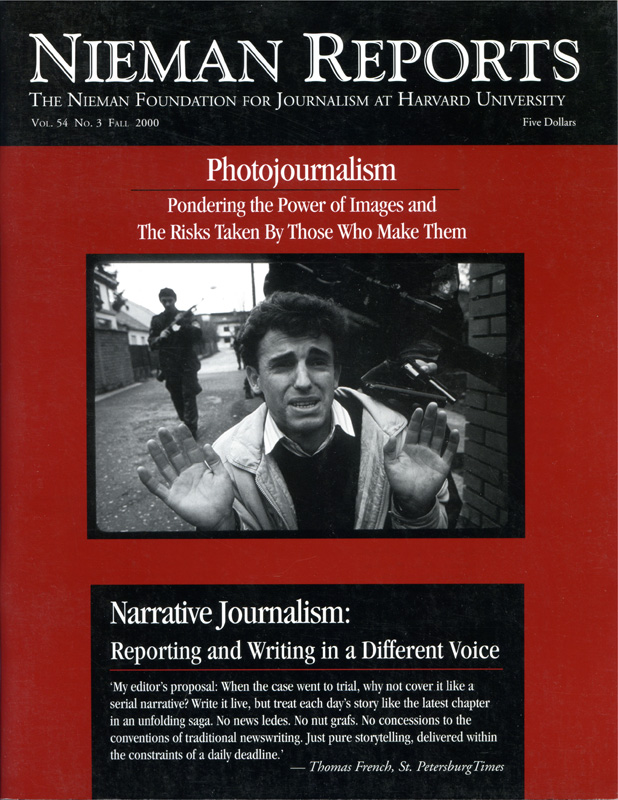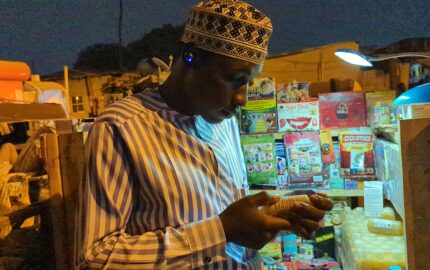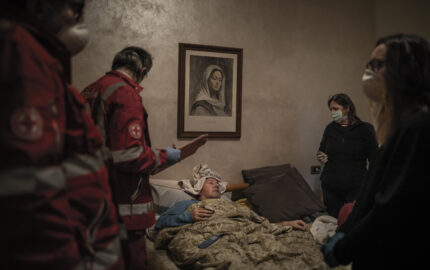

Johnny Htoo, left, a 12-year-old Karen boy, watches as his twin brother, Luther, smokes a cigar during a meeting with the Associated Press at their jungle base in Myanmar in December 1999. Photo by Apichart Weerawong, courtesy of AP Photo.
To make it big in a culture driven by images, there are clear advantages to being photogenic. These days, news reporting seems little different.
And with news, it doesn’t hurt, either, if the essence of an event can be distilled down, à la Hollywood, to a succinct, tabloid-like phrase, such as “Terror Twins,” or “Kid Guerrillas,” or even “War as Child’s Play.”
These headlines were trumpeted by the newsmagazines—Newsweek, Time and U.S. News & World Report—in their February 7, 2000 issues. The news, Time’s inside headline told us, was about “Leading God’s Army: The bizarre tale of boy twins with reputed mystical powers who command a rebellion.” The reason for the coverage, suggested the article, was a photograph: “the picture that shocked the world…the one widely broadcast of Johnny [Htoo] and the cigar-smoking Luther, still at large.”
There was a legitimate news peg. A splinter group of ethnic Karen rebels had crossed the Myanmar-Thai border and taken patients and staff hostage in a Thailand hospital. The small Karen force had commandeered a public bus and seized the hospital to protest the shelling of some Burmese hill tribes by Thai military units acting in cooperation with the military government in Myanmar. Within a day, Thai commandos stormed the hospital 75 miles west of Bangkok, killed the handful or so of Karen fighters, and released hundreds of hostages.
But what propelled this 50-year-old ethnic conflict story into all three newsmagazines and onto all three of the network evening news programs was not the hundreds of hostages, nor their rescue. It was the riveting image of the Janus-faced twins—a month-old photograph of two 12-year-olds who, while the leaders of the 200 or so youthful Karen tribesmen who comprise the force called “God’s Army,” were not actually among the masked gunmen at the hospital.
The photograph pictured two boys looking more like six-year-olds than 12-year-olds, one child feminine in appearance, with long hair and a soft face and expression, the other defiantly masculine, with shaved eyebrows and hairline and smoking the stub of a cigar. Although these youngsters’ images drove the coverage, most media outlets did not take the occasion to reflect on issues relating to children and war, even though earlier that same week the U.N. protocol agreement prohibiting the use of child soldiers in war finally won passage in Geneva, after the United States dropped its long-standing opposition to establishing 18 as the minimum age for sending soldiers into combat.
The media’s herd coverage of the story was not in response to any new understanding of the increased use of child soldiers during the last decade or even to a new interest in the chronic Karen conflict. Most news outlets ran with the story because of their love for gee-whiz items. They counted on viewers’ emotional reaction to the image of the twins.
The compelling photograph also allowed the media to touch on a cultural ambivalence about children in the news. As New York Times reporter Keith Bradsher wrote in 1999 about the public’s response to children who are violent: “Americans are caught between two contradictory impulses: to preserve childhood as a time of innocence and to deny that children who commit crimes are indeed children,” Bradsher observed. Dramatic pictures, especially of children—big-eyed children staring into the camera, children hurt, children fearful, and children dying—can drive coverage. Visual images of child refugees in Kosovo, of swollen-bellied infants in Somalia, and even vivid verbal descriptions of Kuwaiti newborns thrown from hospital incubators (although later shown to be false) can open wallets, prompt politicians to call for humanitarian intervention, and push a story up the news agenda.
Yet, at times, good old-fashioned news values—without an accompanying glitzy photograph—will win a story a place on the front page. One such example was Seth Mydans’ article about the Thai security forces’ rescue of the hostages from the band of Karen guerrillas. His piece received front-page treatment from The New York Times even before the famous image of Johnny and Luther Htoo surfaced. In fact, it was Mydans himself who called the photo to his editors’ attention. The bulldog edition of the paper came out with another AP photo, a more standard one of the Thai security forces. As Mydans, who is stationed in Southeast Asia, described the decision: “We don’t usually consult about pictures but in the morning here—evening there—during discussions of my story I asked if they were running the twins’ shot. They seem to have missed it. They went and found it and put it in. As for that editorial decision, once you see the picture you don’t have to think twice.”
RELATED ARTICLE
"Top 10 Underreported Humanitarian Stories"
- Doctors Without BordersMost international crises have to claw their way into the public’s view, except for those crises involving American troops or those crises that have put—or may put—Americans at risk, such as a mad cow or an Ebola epidemic. Last year, after receiving the Nobel Peace Prize for its humanitarian work, Doctors Without Borders/Médecins Sans Frontières [MSF] took advantage of its brief time in the media spotlight to highlight the crises that members of the press continue to all but ignore. “Victims of chronic conflicts are continually neglected by the media,” said Joelle Tanguy, executive director of the U.S. office of Doctors without Borders. The prolonged wars in Afghanistan, Angola, Burundi, the Congo Republic, and Sri Lanka made the list, as did treatable medical emergencies such as cholera, tuberculosis, meningitis, pneumonia, malaria and sleeping sickness.
Certainly these chronic cases deserve worldwide attention. Such exposure would serve to educate Americans and much of the West and North about these situations. And that exposure would likely be helpful to those who are affected—a key concern, of course, of MSF. Yet, it is very unlikely news editors or producers will be sending off reporters on such stories any time soon. The reasons for such inattention are related to the bottom-line business decisions of owners of news organizations, many of whom in this brave new world of media mergers do not come out of a journalistic tradition. Other reasons for the invisibility of these stories are related to the logistical and bureaucratic imperatives of the news business.
Certain global events are reflexively covered in the American media. These are the no-brainers—“tape at 11”—that even freshly minted editors recognize as meriting front page, top-of-the-news coverage. Such events include the assassination of the Israeli head of state, a massive earthquake in Japan, the ascension to power in South Africa of a former imprisoned black leader, the downing of a plane by terrorist bomb over Scotland.
Then there are other kinds of crises. Sometimes the bottom-line costs for coverage are assessed as being too great: Stationing or even parachuting correspondents into a geographically or psychically remote country for a (presumably) short-term crisis is often seen by the bean counters as not sufficiently cost-effective. Sometimes the personal risks to journalists to cover events appear too great and the story not significant enough to merit such risks being taken, such as during the leveling of Grozny, for instance.
Sometimes, as MSF observes, crises are too chronic; they might be qualitatively at a crisis level, but so static at that level that the immediacy or even the notion of crisis has dissipated for the American audience, such as the ongoing conflict in Algeria. Sometimes events, which are critical in the life and politics of their own nations, do not resonate for the U.S. press because the events take place in regions which fall below the radar of U.S. media notice: This is the case with many events that occur in Africa. Sometimes access is difficult, visas can be denied or even, when print reporters can get in, cameras are forbidden. This has been the case in Syria, for example, and was the case in apartheid South Africa for several years during the 1980’s.
And sometimes sensational breaking news—especially domestic, but on occasion international—will jostle an otherwise “newsworthy” international story off the news budget. It’s harder to get such news on the front pages during the high season of the American election cycle, for example. Even during quieter news moments at home, current media attention to one world crisis will tend to keep other global crises in the dark. This is especially true if the crises can be stereotyped into an analogous category: another ethnic war, for instance, or another famine, or another massacre.
Without the drama of an arresting image, a photo or videotape, either to bring a critical mass of recognition or to reinvigorate a “dying” story (as in the recent case of the video documenting Russian war crimes in Grozny), even those crises which receive coverage in one media outlet typically fade away, having made little impression on the public consciousness. On very limited budgets, many responsible media institutions, such as National Public Radio and a number of the major metropolitan newspapers, try to regularly revisit countries and regions that are typically out of sight. But diligent reporting of an obscure crisis by one or even several journalists can get easily lost in the maelstrom of the constantly churning news cycle.
With the general cutting of news budgets, the media (television especially) can’t afford to cover all the crises in the world. So they choose chauvinistically. Coverage of international affairs is often viewed through the lens of “What does this mean for us?” When there are no obvious or direct repercussions, news items can be struck from the budget, resulting in the situation where distant disasters remain distant and prosaic diseases, such as malaria and virulent diarrhea, which kill thousands and millions every year, are all but invisible.
Not every distant story has a Johnny and Luther able to pose for the camera, able to seize the imagination of the media gatekeepers, able to encapsulate a moral complexity of our time. Walter Lippmann wrote in 1922 that the press was “like the beam of a searchlight that moves restlessly about, bringing one episode and then another out of darkness into vision.” From blackness into blinding glare, then back into blackness. It’s a problematic way of covering the world. But as distorting as it may be, those crises that for some reason do manage to have their moment in the light are the fortunate ones. “Lucky are the people in Yugoslavia and Somalia, for the world is with them,” wrote a missionary in a letter smuggled out of southern Sudan. “It may be a blessing to die or get killed in front of the camera because the world will know.”
Susan Moeller is the author of “Compassion Fatigue: How the Media Sell Disease, Famine, War and Death” (Routledge, 1999). She is currently a fellow at the Joan Shorenstein Center on Press, Politics and Public Policy at the John F. Kennedy School of Government at Harvard University, writing a book to be called “A Hierarchy of Innocence: Images of Children in the News.” Moeller is the director of the Journalism Program at Brandeis University.


